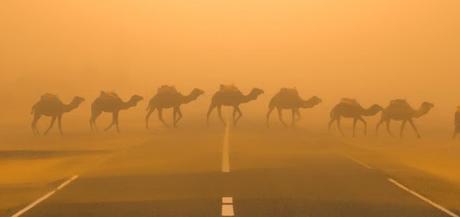In 1987, India reached the finals of Davis Cup but lost to a superior team at their home.It was a time when Sweden was dominating with players like Stefan Edberg, Mat Wilander,Joakim Nystrom, Andres Jarryd – alongside was a player by name Henrik Sundström (I used to read him wrongly as Sand storm) nicknamed Henke, Sundström was at his best on clay and achieved his strongest results on this surface, with his solid and heavy topspin groundstrokes from the baseline. He reached a career-high singles ranking of World No. 6.n In 1984, Sundström contributed for the victorious Swedish Davis Cup team – that allof these matches were on clay was in his favour.His opponents included the reigning French Open champion Ivan Lendl who was still playing for Czechoslovakia at the time. Sundström turned around a 2-sets-to-love and 0–3 (0–40) deficit in the third set, and won the match in 5, which gave the Swedes the edge and they made the final against the United States. The US team included John McEnroe who had lost only 2 matches for the season, Jimmy Connors, and Peter Fleming, John McEnroe's long-term doubles partner.
 Team
India 1987 (S Vasudevan Anand Amirtaraj Ramesh Krishnan; Vijay Amirtaraj not in
pic)
In
geology, saltation (from Latin saltus, "leap") is a specific type of
particle transport by fluids such as wind or water. It occurs when loose
materials are removed from a bed and carried by the fluid, before being
transported back to the surface. As
the force of wind passing over loosely held particles increases, particles of
sand first start to vibrate, then to move across the surface in a process
called saltation.
Sandstorm also
called a dust storm -is a meteorological phenomenon common in arid
and semi-arid regions. Dust storms arise when a gust front or other strong wind
blows loose sand and dirt from a dry surface. Fine particles are transported by
saltation and suspension.The term
sandstorm is used most often in the context of desert dust storms, especially
in the Sahara Desert, or places where sand is a more prevalent soil type than
dirt or rock, when, in addition to fine particles obscuring visibility, a
considerable amount of larger sand particles are blown closer to the surface.
Such sand storms
can carry large amounts of dust, with the leading edge being composed of a wall
of thick dust as much as 1.6 km (0.99 mi) high. Dust and sand storms which come
off the Sahara Desert and an area covering the confluence of Mauritania, Mali,
and Algeria.Saharan dust storms have
increased approximately 10-fold during the half-century since the 1950s,
causing topsoil loss in Niger, Chad, northern Nigeria, and Burkina Faso.
Downunder, Sydney was shrouded in dust during the 2009 Australian dust storm. Dust
storms have also been shown to increase the spread of disease across the globe.
Virus spores in the ground are blown
into the atmosphere by the storms with the minute particles and interact with
urban air pollution.
Team
India 1987 (S Vasudevan Anand Amirtaraj Ramesh Krishnan; Vijay Amirtaraj not in
pic)
In
geology, saltation (from Latin saltus, "leap") is a specific type of
particle transport by fluids such as wind or water. It occurs when loose
materials are removed from a bed and carried by the fluid, before being
transported back to the surface. As
the force of wind passing over loosely held particles increases, particles of
sand first start to vibrate, then to move across the surface in a process
called saltation.
Sandstorm also
called a dust storm -is a meteorological phenomenon common in arid
and semi-arid regions. Dust storms arise when a gust front or other strong wind
blows loose sand and dirt from a dry surface. Fine particles are transported by
saltation and suspension.The term
sandstorm is used most often in the context of desert dust storms, especially
in the Sahara Desert, or places where sand is a more prevalent soil type than
dirt or rock, when, in addition to fine particles obscuring visibility, a
considerable amount of larger sand particles are blown closer to the surface.
Such sand storms
can carry large amounts of dust, with the leading edge being composed of a wall
of thick dust as much as 1.6 km (0.99 mi) high. Dust and sand storms which come
off the Sahara Desert and an area covering the confluence of Mauritania, Mali,
and Algeria.Saharan dust storms have
increased approximately 10-fold during the half-century since the 1950s,
causing topsoil loss in Niger, Chad, northern Nigeria, and Burkina Faso.
Downunder, Sydney was shrouded in dust during the 2009 Australian dust storm. Dust
storms have also been shown to increase the spread of disease across the globe.
Virus spores in the ground are blown
into the atmosphere by the storms with the minute particles and interact with
urban air pollution.
 Dust storms cause
soil loss from the dry lands, and worse, they preferentially remove organic
matter and the nutrient-rich lightest particles, thereby reducing agricultural productivity.
Also, the abrasive effect of the storm damages young crop plants. Dust storms
also reduced visibility affecting aircraft and road transportation. In addition
dust storms also create problems due to complications of breathing in dust.
Dust storms are not
limited to Earth and have been known to form on other planets such as
Mars... .. as we read along the natural
phenomenon – in Brazil, it was created artificially .. yes – A police helicopter in Brazil created a
sandstorm on a beach in an attempt to remove sunbathers flouting coronavirus
restrictions, footage has shown. The incident took place on Friday on Galheta
beach in the city of Florianopolis, Santa Catarina.Although Brazil is not under a national
lockdown, the state of Santa Catarina has been under emergency measures since
17 March.
Now, many of
Brazil’s 850,000 indigenous population are worried about the spread of the
disease and have called for miners, missionaries and other outsiders to leave
the Amazon rainforest. Health experts worry
that the illness could spread even quicker among tribes, as they often have
weak immune systems !! caused by
malnutrition and diseases such as hepatitis B. In 2016, hundreds of indigenous
people in Brazil were killed by the H1N1 epidemic.Brazil has so far recorded 46 deaths from the
disease, with the total number of infections standing at 2,247.
Dust storms cause
soil loss from the dry lands, and worse, they preferentially remove organic
matter and the nutrient-rich lightest particles, thereby reducing agricultural productivity.
Also, the abrasive effect of the storm damages young crop plants. Dust storms
also reduced visibility affecting aircraft and road transportation. In addition
dust storms also create problems due to complications of breathing in dust.
Dust storms are not
limited to Earth and have been known to form on other planets such as
Mars... .. as we read along the natural
phenomenon – in Brazil, it was created artificially .. yes – A police helicopter in Brazil created a
sandstorm on a beach in an attempt to remove sunbathers flouting coronavirus
restrictions, footage has shown. The incident took place on Friday on Galheta
beach in the city of Florianopolis, Santa Catarina.Although Brazil is not under a national
lockdown, the state of Santa Catarina has been under emergency measures since
17 March.
Now, many of
Brazil’s 850,000 indigenous population are worried about the spread of the
disease and have called for miners, missionaries and other outsiders to leave
the Amazon rainforest. Health experts worry
that the illness could spread even quicker among tribes, as they often have
weak immune systems !! caused by
malnutrition and diseases such as hepatitis B. In 2016, hundreds of indigenous
people in Brazil were killed by the H1N1 epidemic.Brazil has so far recorded 46 deaths from the
disease, with the total number of infections standing at 2,247.
With regards – S. Sampathkumar 25.3.2020. Sandstorm pic credit : www.graziame.com/

